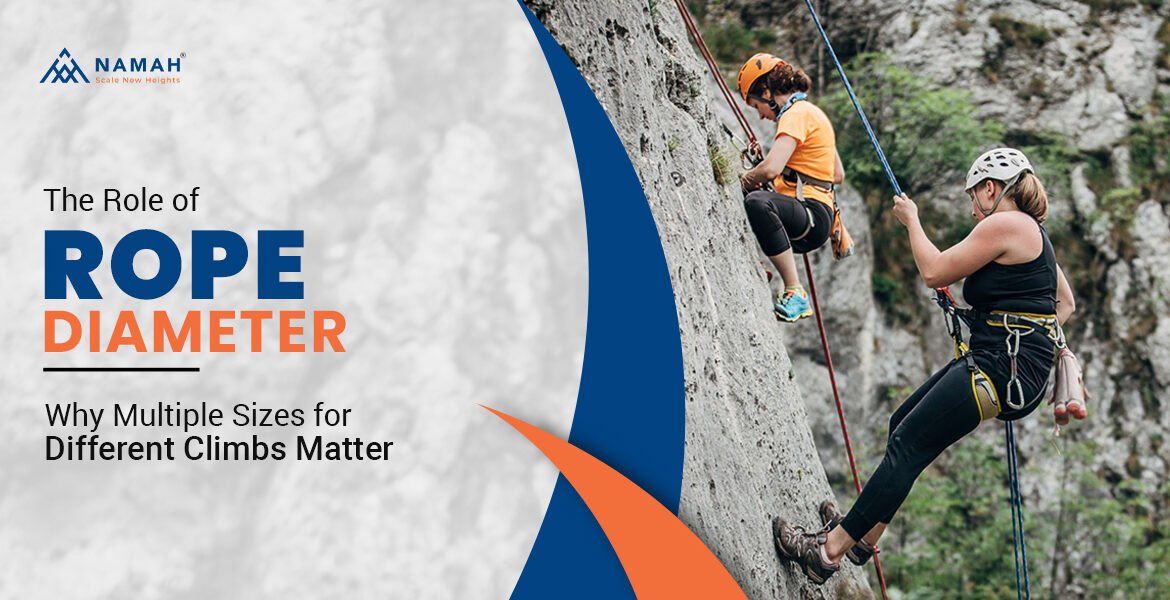If you’ve ever stood in a gear shop or scrolled a product page, wondering why climbing ropes come in so many diameters, you’re not alone. Rope diameter isn’t just a spec; it’s a set of trade-offs that shape how safe you feel on the sharp end, how much effort you spend hauling meters, how your belay device behaves, and how many days of life you’ll coax from your rope.
This guide breaks down what diameter really does, when to size up or down, and why experienced climbers often own more than one rope. We’ll keep the engineering clear, the recommendations practical, and the language human, because your rope is a partner, not just a product description.
You’ll also see a quiet nod to makers who build UIAA-aligned ropes for real-world use. One name that keeps coming up among instructors and weekend climbers alike is Namah, a team that leans into the nuances you’re about to read. The point here isn’t to sell you a single diameter forever; it’s to help you make confident, context-smart choices for every route.
Rope diameter: the simple definition with complex consequences
Diameter is the thickness of the rope’s sheath and core, measured in millimeters. Modern single ropes generally range from the low 9s (around 9.1–9.4 mm) up to roughly 10.2 mm, with “daily driver” sizes in the 9.5–10.0 mm band. Historically, singles were closer to 11 mm; today’s construction and standards allow thinner ropes to meet safety requirements.
Why it matters:
- Handling and feel: Thinner often feeds and clips faster; thicker can feel stiffer but confidence-inspiring.
- Durability: More material usually improves abrasion resistance and extends lifespan in gritty environments.
- Weight and bulk: Skinny ropes weigh less per meter, which matters on long routes and long approaches.
- Fall behavior and elongation: Construction drives energy absorption, but diameter correlates with how “soft” or “firm” a catch can feel.
Standards ensure that certified ropes limit impact forces and meet minimum fall counts in lab conditions. In practice, your rope choice should balance those baseline safety requirements with the exact way you climb.
How diameter affects real-world climbing
1) Belay device behavior
Thinner ropes slide more easily through tubes and assisted-braking devices; thicker ropes create more friction (good for control, slower for feeding). Always check the device’s stated compatible diameter range and adjust technique. With skinny cords, keep an especially vigilant braking hand. With stout lines, be ready to feed assertively to avoid short-roping your leader.
2) Fall “catch” feel
Fall factor is the biggest driver of how hard a catch feels, but construction and diameter modulate that “softness.” Performance-oriented skinny ropes often feel more elastic. Gym-oriented workhorses feel more “firm.” Pick based on route style and partner preference, not just the number on the label.
3) Abrasion resistance and lifespan
Grainy rock and repeated top-roping chew sheaths. A rope with a higher sheath percentage (and sometimes a slightly larger diameter) resists fuzzing, glazing, and flat spots longer. If most of your season is top-roping, a 9.8–10.2 mm with a durable sheath is a smart, budget-friendly choice over time.
4) Rope drag on winding pitches
On wandering trad or mixed lines with several direction changes, skinny ropes reduce drag and your temptation to over-extend runners. If you often follow meandering protection, a 9.2–9.5 mm line can feel noticeably nicer.
Matching rope diameter to specific scenarios
Gym-heavy months
- Pick: 9.8–10.2 mm
- Why: Frequent falls, textured walls, and lots of top-rope mileage punish sheaths. Thicker lasts longer and feels calmer for new belayers.
Sport redpoint season
- Pick: 9.2–9.6 mm
- Why: Less weight for the send go, nimble clipping, enough durability for projecting when paired with mindful belaying.
Weekend cragging (mix of TR and lead)
- Pick: 9.5–9.8 mm
- Why: The balanced choice—durable yet friendly for single-pitch variety.
Long multi-pitch
- Pick: 9.1–9.5 mm single, or a dedicated half/twin system, depending on route complexity and rappel plans
- Why: Weight savings and drag management matter more than pure abrasion resistance; ensure partners and devices are compatible.
Sharp, coarse local stone
- Pick: 9.8–10.0 mm with a higher sheath percentage and a tough weave
- Why: Extra armor where it counts.
Beyond diameter: three construction details that matter
-
Sheath percentage and weave
A higher sheath percentage typically improves abrasion resistance. The exact weave pattern also affects how quickly a rope fuzzes or flattens. If a spec sheet lists sheath percentage, use it to compare durability expectations between models.
-
Dry treatment
Even for sunny cragging, dry treatments reduce water absorption and grit intrusion, helping the rope run cleaner and last longer. In alpine or ice environments, a dry core and sheath are essential for safety.
-
Certification icons and labels
Look for the pictograms indicating single, half, or twin certification. A rope can carry multiple ratings (for example, single plus half), but each system has different clipping and rappel rules. Read the directions and get instructions if you’re new to half/twin techniques.
Safety first: diameter is not a license to neglect care
Whatever you buy, rope care habits determine lifespan:
- Keep it clean. Use a tarp and brush off grit that turns your sheath into sandpaper.
- Rotate ends. Flip your rope regularly to spread wear from repeated lowering and crux falls.
- Manage heat and edges. Lower smoothly, avoid running over sharp edges, and rest the system when it gets hot.
- Retire on time. Follow manufacturer guidance and your own judgment: soft spots, core shots, glazed sections, or dramatic sheath slippage mean it’s done—regardless of how many “falls” it theoretically had left.
Remember, fall ratings are lab measures under specific conditions, not guarantees of real-world lifespan. A carefully handled mid-9 rope can outlast a carelessly used thicker line.
Quick chooser: a human-friendly flow
- New leader or teaching friends? Start around 9.8–10.0 mm.
- Projecting and weight-sensitive? Add 9.2–9.6 mm as your “send” line.
- Mostly gym or top-rope? Stay 9.8–10.2 mm for longevity.
- Wandering trad or long multipitch? Consider 9.1–9.5 mm (or half/twin with proper training).
- Belay device picky? Check the device’s compatible diameter range before you commit.
SEO mini-glossary (for quick scanning and rich snippets)
- Climbing rope diameter: The Thickness of a rope in mm that influences handling, durability, weight, and fall feel.
- UIAA/EN dynamic rope standards: Safety benchmarks defining fall tests, elongation limits, and labeling for dynamic ropes.
- Sheath percentage: Proportion of outer sheath versus core; higher often correlates with better abrasion resistance.
- Single vs half vs twin ropes: Different certifications and clipping methods for varied terrain and redundancy needs.
Summary
In the end, choosing the right rope diameter is more than a technical decision; it’s the fine line between comfort, control, and confidence on the climb. The thickness of your rope shapes how you move, how you fall, and how you trust. A thinner rope may be your ticket to fast alpine pushes, while a thicker one could be your best ally on rugged, gear-heavy routes. At Namah, we don’t just make ropes, we engineer experiences. Every strand is crafted for climbers who demand performance without compromise. Because when you’re hanging high above the world, your rope shouldn’t just hold you, it should empower you to go further.
The takeaway
- Diameter is a choice of compromises. Skinny means light and fast; stout means tough and steady.
- Match the rope to the route and season. Don’t drag your send line through a month of gym laps.
- Standards protect you; technique perfects the system. Use certified ropes, pair them with compatible devices, and belay attentively.
- Owning two diameters is practical. A workhorse and a performer cover almost all real-world climbing.




